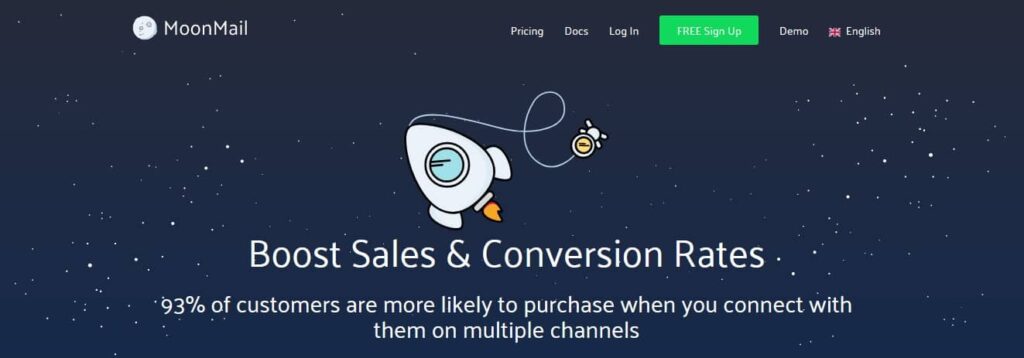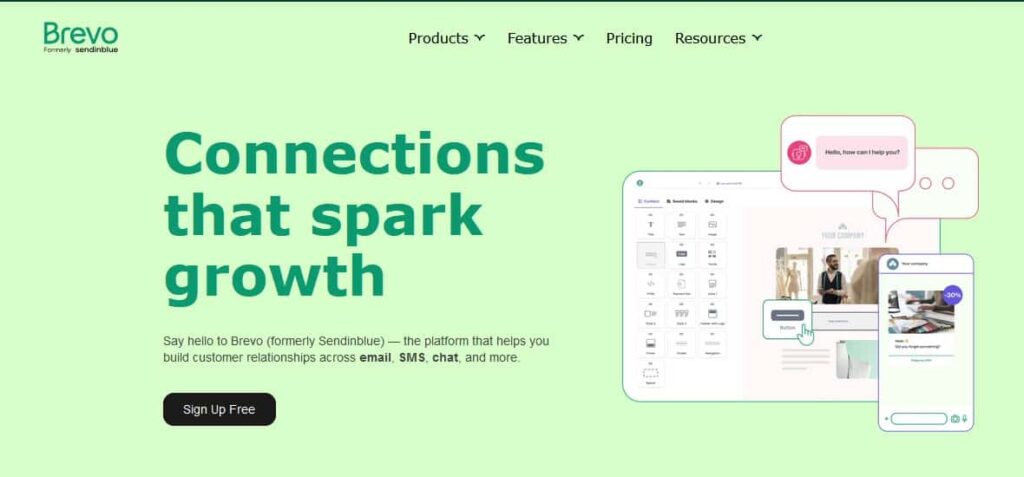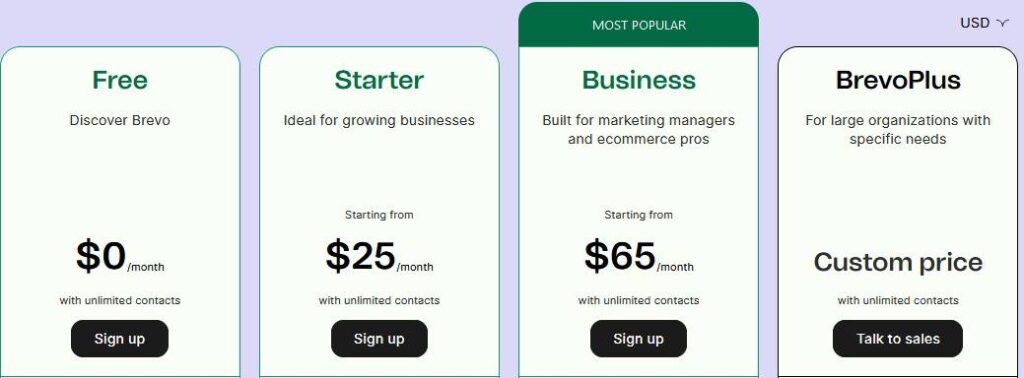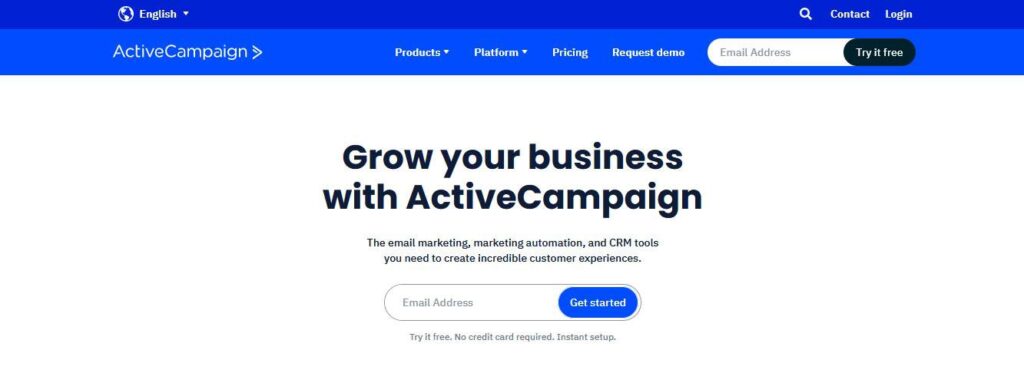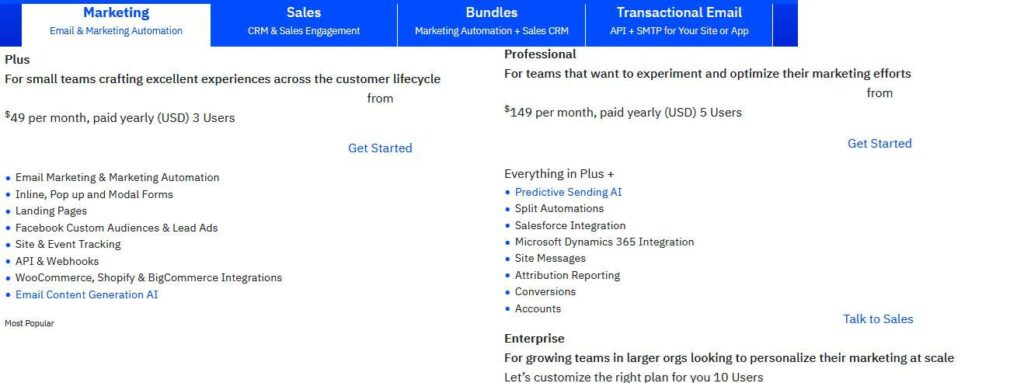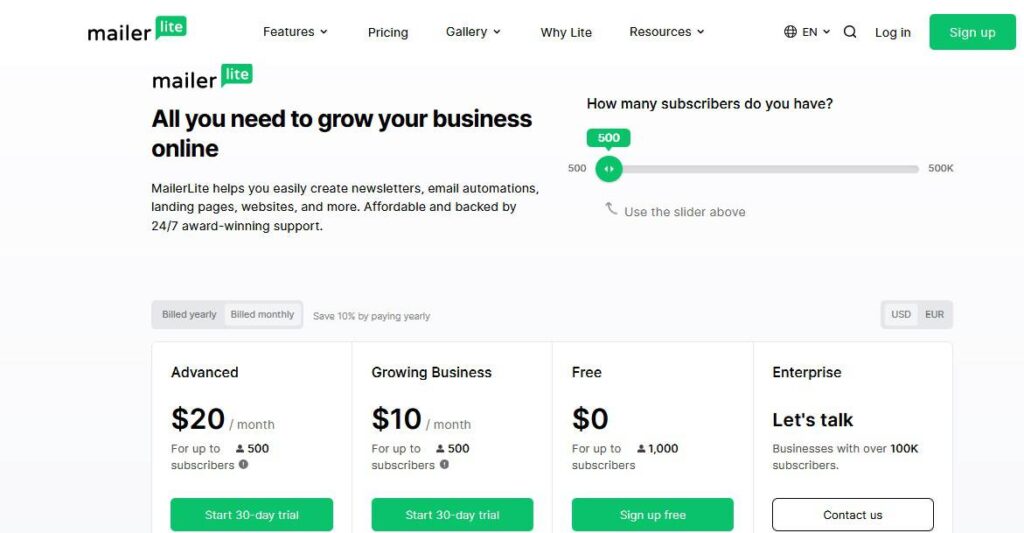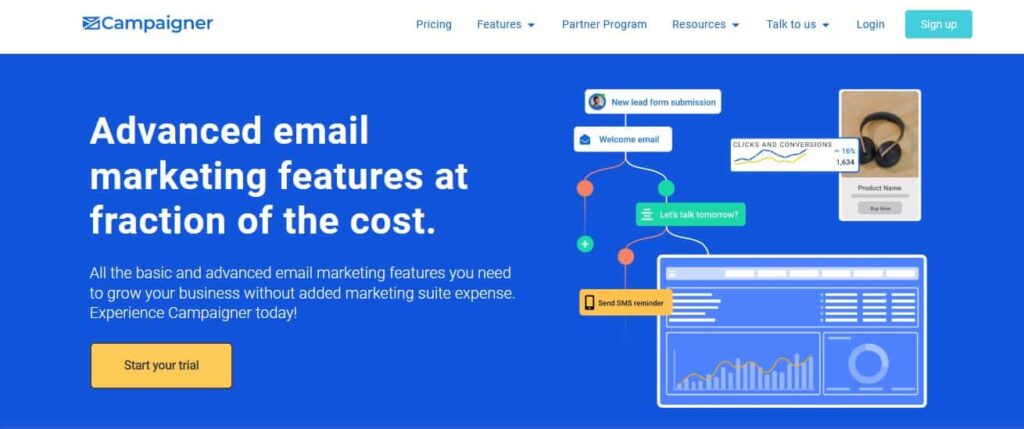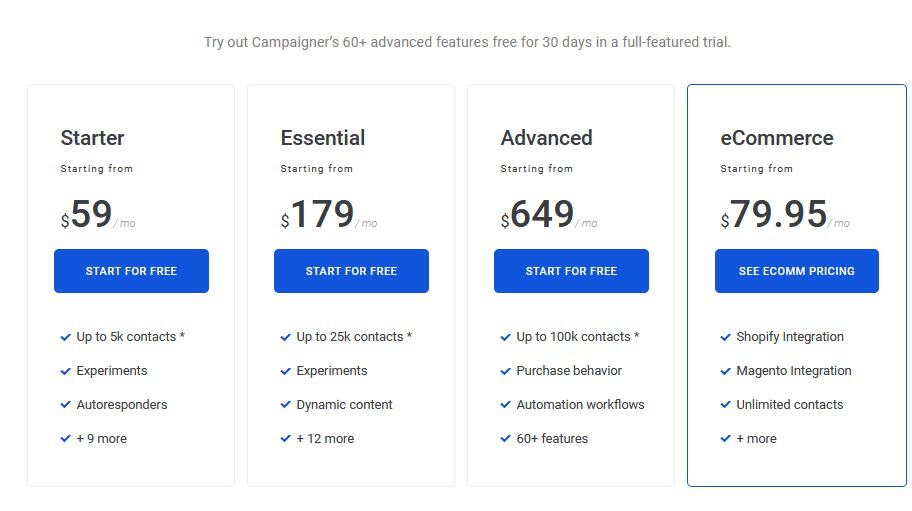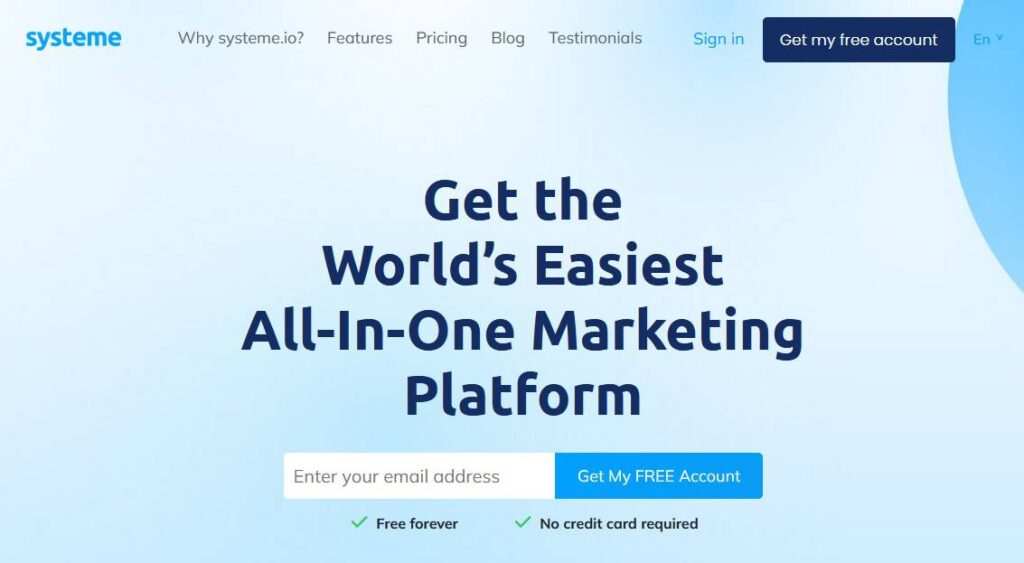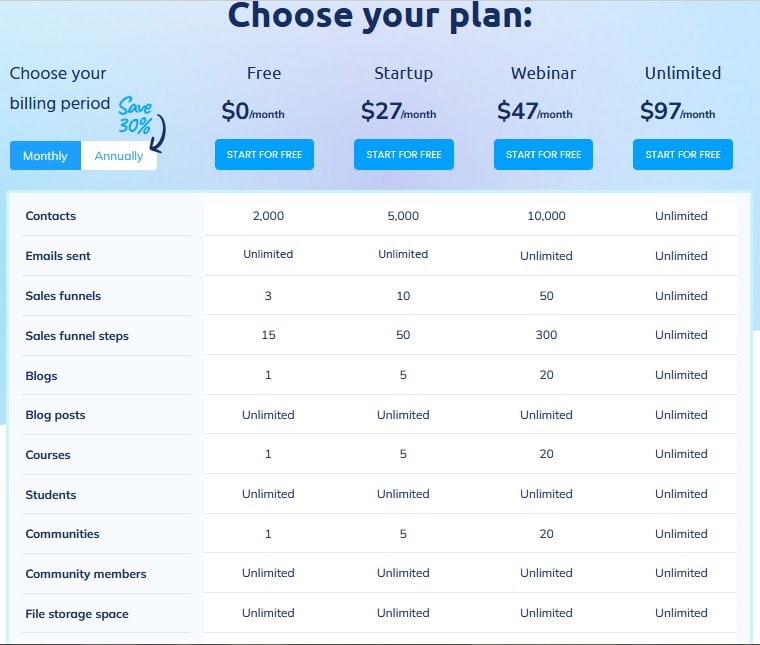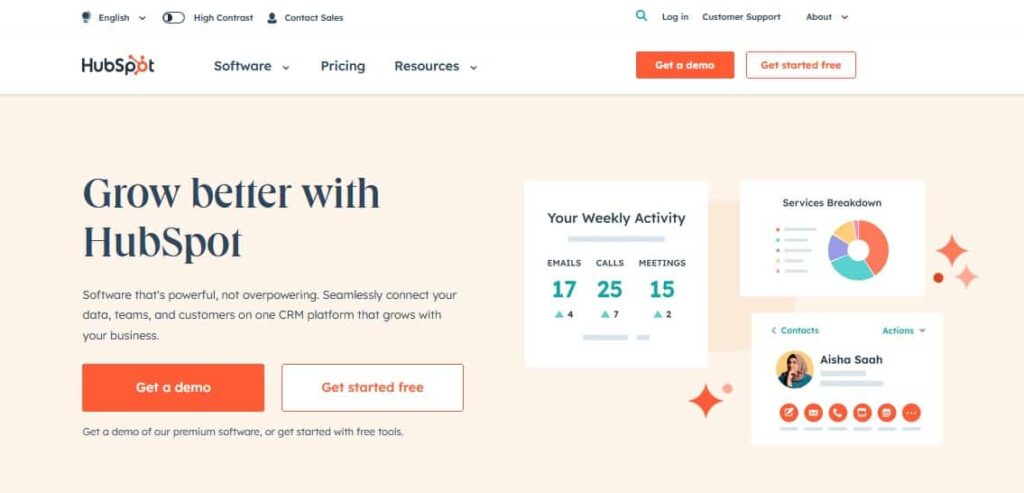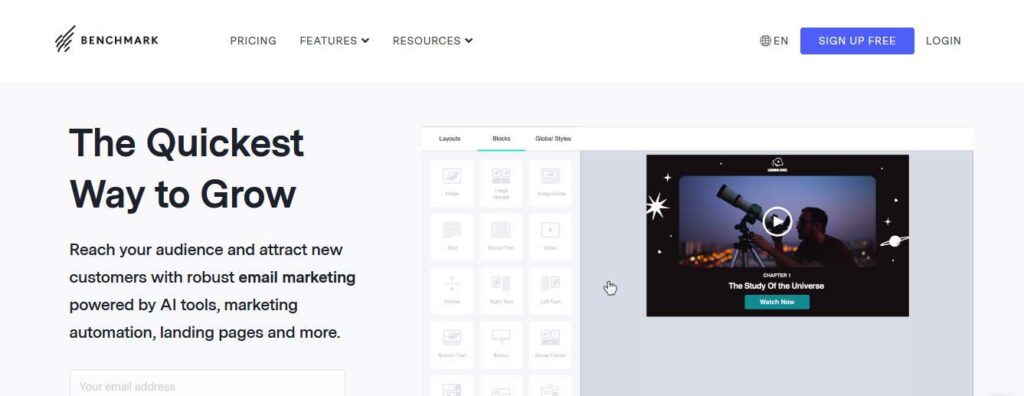Content Marketing Principles: A Beginner’s Guide
Content Marketing Principles: A Beginner's Guide
Nowadays, it happens rarely that a person has a hand in online visibility and didn’t hear about content marketing.
If you are a business owner, whether small or large business, content marketing is vital for your business.
Content marketing principles is so different from traditional kind of marketing. And the good news is content marketing is more effective and grows your business significantly.
Every day much content marketing is produced, but those content help to grow the businesses that have been generated based on content marketing principles. So, if you want to have a successful content marketing campaign, first you should know content marketing principles.
In this article, I talk about content marketing principles, definition and its importance. Steps of creating content marketing, different types of content marketing, and important tips will discuss.

Content marketing vs. traditional marketing
As much as content marketing focuses on the audience, traditional marketing values products or services. If I want to summarize traditional marketing, it will be: “I have the best product. Come and buy from me”!
It’s like what you see in Monday local markets.

Although traditional marketing may imply what’s going on in the local market or past era, it’s common in modern marketing too. Even commercial advertising on television is a type of traditional marketing. They are so boring, and people change channels to get rid of them.
Other examples of traditional marketing are:
- Newspaper
- adsBillboard
- Mail advertisements
- Cold call or text
- Event marketing
- Google ads

Why content marketing is important?
There are many reasons that good and consistent content marketing improves your business. In the following, I note some of the reasons why content marketing is important for every business.
It rescues the audience from confusion
We live in a century where people are selective and also confused with too many options. Just search on the internet to buy a software. Choosing a product among different brands is confusing, and here good content marketing helps.
Good content marketing can save the audience from confusion. Content marketing starts with awareness, then leads the audience to consider their needs and finally make a decision.
The audience wants to choose among different brands, and good content marketing does it very well.

Content marketing becomes more significant when many of your competitors are using traditional methods of marketing. A look at the annual revenue of ad institutions proves it. People hate advertisements. For this reason, they use ad blocks.
So, create good content marketing, give awareness to your audience, and achieve your marketing goals.
It is a win-win.
It's not expensive
In contrast to television and publishing advertisements in newspapers or magazines, content marketing doesn’t need to expensive budget. Everyone can do it online. You need to know the strategies of content marketing. Then enjoy the long-term results.
It helps online visibility
Content marketing is all about helping, not selling. It’s exactly something Google wants. Google appreciates content that helps people. When people are satisfied with your content, google also will be satisfied. Just you need to include SEO basics and strategies in content. Then Google and the audience help you for more visibility.
It causes the audience to trust your brand
When people type a query in the search engines, regardless of their intention, they need help. Through content marketing, you answer their questions and interact with them.
It is the same as creating value without taking anything in return, and your audience is more likely to trust your recommendations.
The more quality content that visitors see, the more likely they have a positive association with your company.
Content marketing principles
After a short introduction and talking about the importance of content marketing, let’s dive into the discussion and talk about principles of content marketing and how good content marketing can organize.
Principle 1: Change your mindset
If you are new in content marketing scope, it means you have a traditional marketing mindset. Content marketing is very different; it needs to be treated differently. Also, will get different results.
You should look at content marketing as an investment, not a short term entertainment.
Content marketing is like a startup; it needs consistency and effort. You must be careful about your audience’s needs while you have marketing goals in your mind.
Think about yourself as a publisher and, what you publish becomes your asset. Having such a mindset means thinking you about all resources that create and distribute content differently. It is creating long-term engagement with customers through your content.
When you look at your content as a long-term investment, quality increase, and the audience understand you are different. So, they don’t leave simply; they stop and think. Then, this audience engages with your content and subscribes as loyal customer.
Principle 2: Define your own goals
When you write content in marketing fields, you have commercial goals in your mind.
Based on the types of your business, B2B or B2C, your goals will be various.
Here are some common content marketing goals for B2B or B2C types:
B2B Content Marketing Goals
- Problem-Solving: The main goal of a B2B brand is to solve the problems of customers. So, as a B2B brand need to show your expertise with the quality of your content. Your content should pay attention to the pain points of customers and find the solution.
- Credibility: It doesn’t happen overnight and needs authenticity. The more authentic and reliable your content is, the more credibility your work shows.
- Partnership: This item is crucial and can bring value to your brand. But how does your audience trust you? It often happens when you focus on their needs in your content strongly.
B2C Content Marketing Goals
- Trust Building: It’s one of the primary goals of content marketing. Trust building is a time-consuming process. It often needs some trial and error.
- Audience engagement: It seeks for the ways people engage with your content. Audience engagement can be done in different ways such as sharing, liking, or commenting on your content.
- More traffic: Content marketers hope to gain more organic traffic in search engine. Combining content marketing and SEO with keyword-optimized blogs helps to achieve this goal.
- More sales: It is the most common goal for every business. Create content to show your business’s worth, and sell more.
Principle 3: Define Audience Persona
Since all the content marketing start and ends with your audience, therefore the writer should understand the wants and needs of audience very well.
You need to know about interests, pain points, sometimes gender or age of your audience. Following questions help you to gain more knowledge about your audience persona and then write your content accordingly.
1- Which gender are them?
2- Where can find them?
3- What’re their goals?
4- What’re their pain points?
5- How much is their budget?
6- How do they live the average of a day?
7- How can I help them?
8- What does make them happy?
And many other questions to define them truly.
You need to these information because you must write specifically not broad. Some people write a broad content marketing but finally it’s not useful for anybody.
Principle 4: Manage content creation process
All this step is about who writes the content. It deeply related to size of your organization, your budget and your content marketing knowledge.
If you are new blogger with limit budget, so you should increase your knowledge and start your content marketing. Or if you are new and have the budget, you can outsource your content marketing to professional ones.
For organizations it works differently. Since they work in large extent, therefore they need to hire different persons for different job positions such as Chief content officer (CCO), Managing editor(s) Content creators, Content producers and etc.
Principle 5: Find keywords
This step is super important. All of your efforts is for online visibility and finding potential customers. But if you don’t select right keywords, competitors steal the audience.
If you know SEO well, you should include it. Also you can use SEO tools to find right keywords. Otherwise it’s better to outsource your content marketing to implement keywords too.
The keywords should be according to problems your business solves. Aligning your content marketing with problems solving will give you a greater perspective of how customers see your brand.
Principle 6: Don't talk about sales
Paradoxically, the less talk about sales can leads to more sales. Just focus on helping audience. Selling will come at the right time.
Just focus on helping audience. Selling will come at the right time.
As a content marketer, it’s important to remember that your primary goal is not to sell products or services. Instead, you aim to provide valuable information and resources to your audience in order to establish trust and credibility with them.
Talking about sales too much can come across as pushy or insincere, which can turn off potential customers.
Principle 7: Find your own point of view and voice
Finding your own point of view and voice as a content marketer requires research, analysis, and self-reflection.
By understanding your audience, developing a unique perspective, and staying authentic, you can create content that stands out and resonates with your target market.
Principle 8: Use ''Call To Action '' in your content
CTA encourages the readers to take a specific action. CTA is your marketing aim. For example, purchasing a service or signing up for a newsletter.
A good CTA is clear and concise. The language used should be direct and easy to understand. For example, it’s better to say ”subscribe here” instead of saying “click here”. People don’t like click on unknown links.
Another key factor to consider is placement of the CTA. It should be strategically placed throughout the content, such as at the end of a blog post or within a video. This ensures that the reader or viewer has had enough time to engage with the content before being prompted to take action.
Principle 9: Plan an editorial calendar
One of important factors in content marketing is consistency.
You can’t going fast for a while and disappear for sometimes. You should go ahead smoothly but consistently.
It’s not possible without an editorial calendar (content planner tool).

A content planner tool maps content production, prepares right content in right time, scheduling dates of creation and publishing, workflow steps and more.
Content planner can be in different forms; from handy format to printed calendar, a spreadsheet like Google calendar to editorial tool. These tools enable you to track the types of content you wish to create, your titles, authors, and publish date and more.
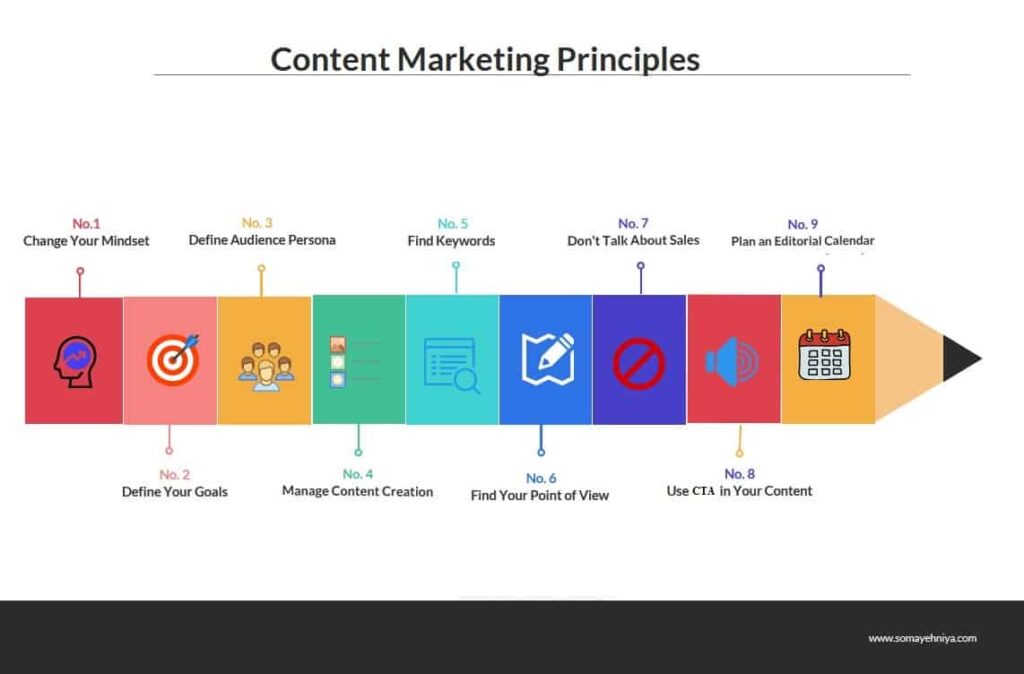
Types of content marketing
The name of content marketing implies just written types of content. Although it is mostly in written format, this scope includes other formats too.
Let’s dive into some ways for impressing your audience with your content
Blog posts
When we hear about content marketing, the first thing that comes to our mind is blog posts. Actually, blogs are the best place for any type of content marketing.
Blog posts should along with SEO and the right keywords. Length is important, but don’t obsess about long posts. There is no guarantee your 8000 words post rank on Google. Don’t scarify quality for the sake of quantity. A medium-length post with 2000~3000 words is enough.
When you write a blog post be careful about below items to gain traffic:
- Use strategies for choosing keyword
- Link your content to a high-authority website
- Make sure to choose the right headlines
- Audit the speed of your website
- Don’t forget mobile-friendly for SEO
Infographics
It is a visual representation of information. By telling many words in a picture, not only your task becomes easier, but also the audience like it.
Try to create eye-catching infographics. They help your business more than you think.
If you use infographics for blog posts, don’t forget to use descriptive and informative alt text that includes keywords too. Otherwise, search engines can’t find your infographic.
Videos
This type of content is such widespread and informative that they also have specific platforms like Youtube. You can use videos everywhere from social media to blog posts.
If you want to make a brand, nothing can help you like videos. It’s the way of all well-known brands. The main problem with making videos is its time-consuming process and also needs many resources but in return, they generate great results.
eBooks
Books always are effective. eBooks are long-form texts that need more time to produce. But they don’t have difficulties of published books by the press. eBook as content marketing isn’t for sale generally. It’s a lead magnet to give value to your customers or indeed you give this value to your own business.
eBook is a powerful marketing tool. You can offer it to visitors of your blog when they enter your website. Just don’t forget to include links to your website in your eBook for further information. It can bring good traffic to your website.
Case studies
If you want to prove your expertise to the audience, case studies are the best choice. A good case study starts by defining the problem, deeply goes to solving process, and finishes by solving the problem. When you write case studies pay attention to below points:
- Start with a clear headline
- Write in simple language as much as possible
- Define the problem and explain solving process clearly
- Includes statistics in your case study
How-to guides
Since the main perspective of content marketing is helping the audience, in-depth how-to guides content significantly improves your traffic.
People don’t forget the website helps them to solve a problem, and it’s the reason they come back to your website again.
For example, on my site, I have a distinct part for how-to guides related to SEO and content marketing.
Podcasts
Podcast is a digital audio file that the audience can either stream or download. Podcasts allow you to share your experiences directly with your audience, building relationships by speaking to your targets on a personal level.
Email marketing
Email marketing as content marketing is a powerful tool that can use to engage and retain the audience. By creating valuable and relevant content, build trust with your subscribers and establish yourself as an authority in your industry.
One of the key benefits of email marketing is its ability to reach a large audience at once. Another advantage of email marketing as content marketing is the personalization of messages for each subscriber. By segmenting your list based on interests or behavior, you can tailor your content to meet the specific needs of each individual.
Tips for improving your content marketing
Content marketing is one powerful muscle in business. Many people from personal blogs to large organizations do it. But not all be successful. Indeed, a few percent are successful.
In the following, there are some tips improving your success significantly.
Using AI tools for writing content marketing
AI tools can greatly enhance the efficiency and effectiveness of your content marketing.
One of the benefits of using an AI tool is its ability to generate relevant and engaging content ideas. By analyzing vast amounts of data, these tools can suggest topics that likely will resonate with your target audience. This saves valuable time that would otherwise be spent brainstorming ideas or conducting extensive research.
Understand the buyer's journey
In simple language buyer’s journey is the process a buyer start from an online search to purchase a product or a service. It includes three below steps. Each step is separate and needs special content marketing:
- Awareness: This is the stage buyer searches online to solve a problem. They want to understand more about it.
Here your first content marketing as blog posts, and social media posts open the door for the first interaction.
- Consideration: Buyer considers all available approaches or methods to solve the defined problem.
In this stage, produce informative and more personalized content. Your content in formats like ebooks, webinars, and newsletter is helpful. Your aim yet is helping not selling. But you should have a kind of call to action in your content. But in helping form not pushing.
- Decision making: Now the buyer is ready to buy a service or products to solve the problem.
Use content like your case studies or demos to show how your brand rises above the competition and better solves its problem.
Use simple language
Life is busy and people don’t like to spend their time for a complicated content. In blogging world complicated content doesn’t mean sophisticated writer. It means low traffic!
So, simple language=happy audience & happy Google.
Use simple words and short sentences.
Try for paragraph 3~4 sentences.
Keep your brand voice consistency
A brand voice is the personality of a brand in interaction with customers. It helps your brand become more recognizable among various marketing channels.
For having a brand voice you should identify your vision, mission, and values and make highlight different aspects of your business. It helps your brand become outstanding.
Keeping your brand show you’re strong in your mission, and it will bring authenticity to you.
Produce various content
Don’t limit your business to a type of content. Nowadays audiences are very different from each other and consequently, their interests also are different.
Also sometimes different types of content are more comfortable regarding their time limitation. So, includes variety in your content type.
Edit content before publishing
Importance of comprehensive editing in content marketing cannot be overlooked. It allows you to refine, optimize, and tailor your content to effectively communicate your message, enhance your brand’s credibility, and engage your target audience.
By investing time and effort into the editing process, you can ensure that the content stands out in a crowded digital landscape and drives meaningful results for your business.
Analyze your content marketing performance
To analyze your content marketing:
- Set your KPIs: You should define your key performance indicators (KPIs) and your goals. KPI is a measurable value that shows how effectively a business is achieving key goals. In other words, it’s setting goals to achieve.
- Select a Tool to Track Metrics: Once you define your goals, choose the appropriate content marketing analytics tool to track the metrics. Content marketing tools help you to gain insight into the performance of your content marketing strategies.
- Analyze data: Content marketing analytics tools help you to make decisions to improve your content marketing strategy. Analyze the results carefully to know what’s right and what needs to improve.
- Optimize the results: Based on your analysis optimize your content. Optimization should be an integral part of your content marketing. In this way, your content remains fresh.
Conclusion
The goal of content marketing is to create and distribute content that is useful to your target audience and encourages them to take action.
It is an effective way to build relationships with potential customers, establish authority and credibility in the industry, and increase visibility online. By providing quality content, businesses can demonstrate their expertise and become a trusted source of information for their target audience.
FAQs
What is content marketing?
Content marketing is a strategic approach to create and distribute valuable, relevant, and consistent content to attract and retain a clearly-defined audience and ultimately, to drive profitable customer action.
Why content marketing is important?
Content marketing is an important because it is cost effective, generate leads, create brand awareness, influence conversion and create authority. Content marketing is a powerful tool for businesses of all sizes and can help to drive growth and increase revenue.
What are different types of content marketing?
Content marketing can take many forms, including blog posts, videos, podcasts, infographics, ebooks, whitepapers, case studies, webinars, and more.
How does content marketing work without talking about selling products?
Goal of content marketing is not to directly sell products or services, but rather to build relationships with potential customers. By providing valuable information and engaging content, you can create an emotional connection with your audience and establish trust. Once this trust has been established, it will be much easier for them to make a purchase decision when the time comes.



